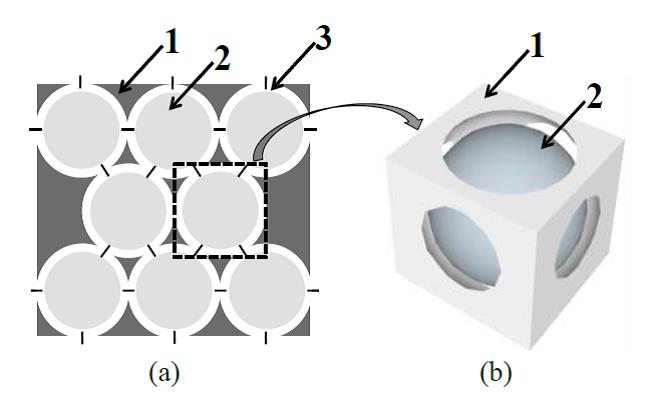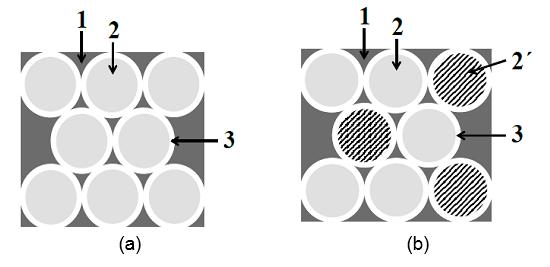Can we help you?
Contact us

Can we help you?
Contact us

Thank you for contacting us
Your form has been submitted successfully Our team will contact you again as soon as possible.
Whooppss...!! An error has occurred
Try sending later or write an email directly to areaempresas@ua.es

 PATENTED TECHNOLOGY
PATENTED TECHNOLOGY
INFO
SHEET
DOWNLOAD
EXECUTIVE
ABSTRACT
CONTACT DETAILS: Research Results Transfer Office-OTRI
University of Alicante
Tel.: +34 96 590 99 59
Email: areaempresas@ua.es
http://innoua.ua.es
The "Advanced Materials" research group at the University of Alicante has developed a foamed material comprising three phases: a structural matrix, at least one host phase, and a fluid. This material is characterized by the fact that the structural matrix comprises a plurality of interconnected porous cavities, the host phase(s) is/are housed within at least one porous cavity of the structural matrix and the fluid is housed within the porous cavities. The host phase(s) is/are housed within the porous cavities of the structural matrix without maintaining any bond with the latter.
The structural matrix may consist of a material of a metallic, polymeric or ceramic nature or mixtures thereof. Meanwhile, the host phase(s) is/are a functional material, the fluid being a liquid or a gas.
These materials have many potential uses, among which one is as a catalyst material or as a support for catalysts.
Companies interested in the commercial exploitation of this material are sought through a patent license agreement.

Interconnected pore foamed materials have been known for a long time. In this sense, many methods have been developed for the manufacture of foamed materials from metals, ceramics and polymers.
Of all the methods developed, the one that allows the best control of the obtained material is the method of infiltration of martyr preforms or also known as replication method. This method offers materials with multiple advantages, since the pores of the foamed material have the characteristics of size, size distribution and shape of the particles or fibers of the original preform constituted by the sacrificial material.
Foams manufactured by replication have a wide spectrum of applications, given the fact that they can be designed according to specific needs. Some of them have proved to be suitable as support for catalysts in gas or liquid phase reactions, since the presence of interconnected pores allows the passage of fluid through them and therefore they can be used in continuous reactors. However, their use has not been extended for this application due to the fact that foams intended to be used as support for catalysts must meet two, often contradictory, requirements:
(i) foams must have a high specific surface area so as to allow a high dispersion of the catalytically active phase;
(ii) the pore size must not be too small to prevent the pressure drop of the fluid passing through it from being too large.
In addition, foams intended to be used for these purposes must comply with another property: their thermal conductivity must be as high as possible in order to favour the transport of heat from or to the outside of the catalytic reactor (for endothermic or exothermic reactions, respectively).
Some of the most recent developments in foams seem to combine the properties of good permeability to the passage of fluids with high thermal conductivities, as well as allowing the specific surface area of foams to be increased by incorporating catalytic nanoparticles or supporting catalysts anchored to the pore surface of the foams. In any case, the specific surface area of these foamed materials (around 1m2/g) is still relatively low to be used in some catalytic applications.
There is therefore a need to develop new foamed materials of simple manufacture and with improved properties whose functionality is not limited by the material of which the foamed material is made, as well as by the size, shape and size distribution of their pores.
The "Advanced Materials" research group at the University of Alicante has developed a foamed material with application in catalysis that comprises a structural matrix, at least one host phase and a fluid.
This foamed material is characterized because the structural matrix comprises a plurality of interconnected porous cavities, the host phase is housed within at least one porous cavity of the structural matrix and the fluid is housed within the porous cavity (Figure 1).

The host phase, in a finely divided form of particles or fibres, is housed within the porous cavity of the structural matrix, and maintains no bond with it, so that between the walls of the porous cavity of the foamed material and the surface of the host phase there is a space gauge that is occupied by the fluid.
The structural matrix of the foamed material may consist of a material of a metallic, ceramic or polymer nature or mixtures thereof.
The host phase of the foamed material, preferably in a finely divided state (particles or fibres), is a functional material, i.e. any material that confers a certain function, such as, for example, an adsorbent function. These include: carbon, active carbon, organo-metallic skeleton materials (MOFs), etc. The foamed material can be made up of several host phases of a different nature, so that each of them provides a different functionality to the final foamed material.
The fluid inside the porous cavity of the foamed material can be a gas or a liquid. This fluid is found surrounding the entire host phase(s) in the porous cavity in such a way that the fluid can circulate within the foamed material, as it has interconnected porosity, and renew itself if a pressure gradient is imposed at its ends.
The host phase(s) of the foamed material can be housed in all or part of the porous cavities, leaving the host phase free and the rest of the cavities completely occupied by the fluid (Figure 2).


MAIN ADVANTAGES OF THE TECHNOLOGY
The foamed material described has the following advantages:
• Since the structural matrix and the host phase(s) are not bonded, both fulfil their functionality independently.
• The matrix phase can be of a material that has good mechanical and thermal properties, so that it can withstand mechanical stresses derived from industrial catalytic use and adequately transport heat to or from the reactor.
• The host phase(s) can be a material with varied mechanical properties and with a high specific surface area (functional material), so that the material as a whole has a higher surface area than conventional foams used in catalytic applications.
The competitive advantages of this material with respect to those used in catalysis are the following:
• With suitable graphite or metallic matrices, materials with very high thermal conductivities are obtained, which allow the heat to be transported to or from the reactor.
• With high specific surface host phases (e.g. active carbons, zeolites, etc.) much higher specific surface values are achieved than conventional ones measured for foams (0.3 m2/g) or foams with nanoparticles on the porous surface (<1m2/g).
• The host phase(s) can be a catalyst material or support catalysts and its catalytic functionality is ensured by its configuration in the final material.
• Multi-catalytic materials can be designed by combining different host phases with the advantage that the catalytically active centres are physically differentiated.
INNOVATIVE ASPECTS
In the field of catalysis there is no material with the characteristics of the described material. The material has passed a patentability examination.
The material has been developed on a laboratory scale, although the infiltration processes are easily scalable.
The present invention falls within the field of foamed materials and in particular refers to an interconnected pore foamed material containing within its porous cavities at least one host phase, which gives specific functionalities to the foamed material.
This material is particularly useful as a catalyst material or as a support material for catalysts. The material allows catalytic active materials to be housed in the host phases and ensures that the passage of fluids through it. In addition, this material can be considered multi-catalytic when different host phases are combined, which allow the different catalytic centres to be physically separated.
In addition to this use, foamed material can also be used:
• For the controlled release of chemicals or pharmaceuticals.
• For the adsorption of gases, liquids or dissolved solids.
• As an implant material.
• As a filter for inorganic or biological substances.
• As a magnetic material.
• As impact absorbing material in passive safety parts of land, air and sea transport vehicles.
• As an electromagnetic radiation absorber material for conversion into heat or electrical energy.
• As radar wave resonator material, applied in radar invisibility technologies.
• As a template material for crystalline growth in the gap between the structural matrix and the host phase(s).
The research group is looking for companies, especially manufacturers of catalysts, interested in acquiring this technology for commercial exploitation through:
• Patent licensing agreements to assign the rights of use, manufacture or marketing of the technology to third parties.
• R&D project agreements (technical cooperation) for the development of new applications, adapting the technology to the specific needs of the company, etc.
• Subcontracting agreements for technical assistance, training, etc.
This technology is protected by patent .
- Title of the patent: "Foamed materials of pore interconnected with host phases, procedure for the preparation of such materials and uses thereof".
- Application number: P201730890
- Application date: 05 - 07 - 2017
Materials and Nanotechnology
Medicine and Health
Chemical Technology
Transport and Automotive
Carretera San Vicente del Raspeig s/n - 03690 San Vicente del Raspeig - Alicante
Tel.: (+34) 965 90 9959





